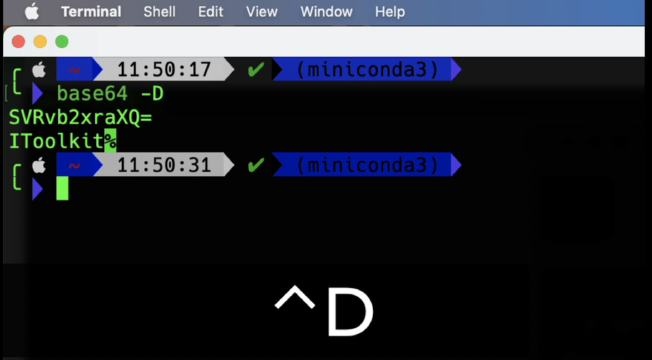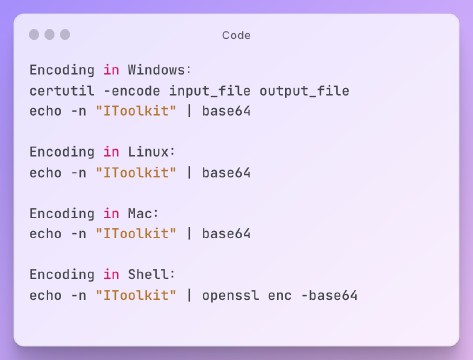Excerpt§
Base64 is an encoding scheme that converts binary data into plain ASCII text format. It is commonly used to enable embedding files, images, and other binary data inside textual documents and protocols.
Base64 encoding is a common technique used across many computing applications and languages. But what exactly is Base64 and why is it useful? In this post, we’ll examine what Base64 encoding is, why it’s helpful, and some examples of its use cases.
What is Base64 Encoding?§
Base64 is a group of encoding schemes that represent binary data in an ASCII string format. It uses a 64 character set made up of upper and lowercase letters, digits, and two extra characters “+” and “/”.
Base64 takes each binary byte and converts it into a 6-bit value. Four 6-bit values together represent three bytes of data. This allows three bytes (24 bits) to be converted into four 6-bit Base64 characters.
For example, the string “IToolkit” in ASCII is:
149 54 6f 6f 6c 6b 69 74
textIn Base64, this converts to:
1SVRvb2xraXQ=
textThe “=” padding character is used when the binary data length isn’t evenly divisible by three bytes.
Advantages of Base64 Encoding§
There are a few key advantages that make Base64 encoding useful:
Encodes Binary Data as Text§
Base64 converts binary data into a plain text ASCII format using characters like A-Z, a-z, 0-9, +, and /. This allows binary data such as images, files, etc to be represented in a text format.
Uses Standard ASCII Characters§
The Base64 character set uses standard ASCII printable characters. This means Base64 encoded data can be handled almost universally across different systems.
Wide Support Across Languages§
Most modern languages have support for Base64 encoding/decoding built in or available via libraries. This makes it easy to share Base64 data.
Use Cases for Base64 Encoding§
Some common use cases where Base64 shines:
Embedding Binary Data in Text Documents§
JSON, XML, email, and other text formats don’t handle raw binary data well. Base64 provides a way to represent binaries in a text format that can be embedded in these documents.
For example, embedding a small image inline with an email body.
Transferring Binary Data Through Text Protocols§
Protocols like HTTP, SMTP, IRC are designed around text. Base64 enables transferring binary data through these protocols since it encodes the data as text characters.
Storing Binary Data in Text Databases§
Many databases like MongoDB and Redis only support string values. Encoding binary blobs as Base64 allows storing them in record text fields in these databases.
How Base64 Encoding Works§
To understand Base64, let’s walk through a simple encoding example.
We’ll start with the ASCII string “IToolkit”. In binary this is:
101001000 01010100 01101111 01101111 01101100 01101011 01101001 01110100
textBase64 encoding works by splitting the binary into 6-bit chunks.
101001000 = 6 bits = I
201010100 = 6 bits = T
3...
textEvery four 6-bit values gets converted into three bytes (24 bits). The 6-bit values encode into a corresponding Base64 character based on a translation table.
If the binary data length isn’t evenly divisible by 24 bits, the “=” padding character is appended to complete the encoding.
This 24 bit to 4 character scheme allows Base64 to reduce the space needed for encoding by 1/3 compared to regular ASCII encoding.
The tradeoff is that Base64 encoding increases the encoded data size by 33% more than the original binary. But for many use cases this overhead is acceptable for a simple text representation of binary data.
Alternatives to Base64§
Base64 isn’t the only option for encoding binary data as text. Some alternatives include:
Hexadecimal Encoding§
Hexadecimal uses a-f and 0-9 to encode binary data as text. It requires more characters than Base64 (2 instead of 1.33 per byte), so the encoded size is larger.
Binary Serialization Formats§
There are compact binary formats like BSON that can serialize binary data. But these formats aren’t as portable across different mediums.
When to Use Base64 Encoding§
Base64 makes sense in situations where you need a text representation of binary data. Some examples:
- Embedding image files or other binary inside XML, JSON, or email bodies
- Transferring files through text-based protocols like HTTP, SMTP
- Storing binary blobs in MongoDB, Redis, or other databases that don’t support raw binary
Base64 provides a simple encoding that is widely supported across platforms and languages.
Limitations of Base64§
Base64 has some drawbacks to consider:
- Encoded size is 33% larger than the original binary data
- No compression or optimization for traffic or storage
- Some symbols like “/” and “+” may cause problems in file names or URLs
For pure storage efficiency or transmission, better options are dedicated binary formats like BSON, MessagePack, etc.
Summary§
Base64 encoding provides a clever way to represent any binary data in a plain text format using a wide range of common characters. It’s useful in situations where you need maximum compatibility across different systems, languages, protocols, and services. While Base64 comes with a size increase tradeoff, this overhead is reasonable in many use cases that require transporting and embedding binary data in text formats.















